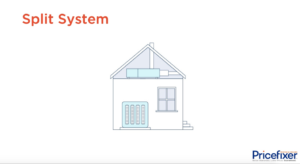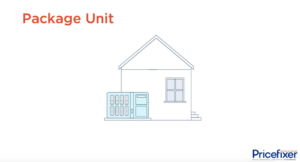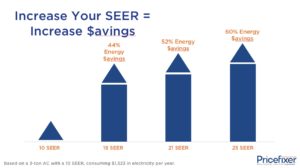Do I Need an AC or a Heat Pump to Cool My House?
You’ve decided it’s time to update your home’s heating and air conditioning unit to a more energy-efficient system, and you’re excited about all the money you’ll be saving on your utility bills and shrinking your carbon footprint. But, as you start to do your due diligence research on HVAC systems, you discover there’s another energy-efficient cooling system besides the traditional central AC unit that many people are choosing to put in their homes instead: the heat pump. You begin to wonder, “Should I get a heat pump?” “What’s the difference between a heat pump and an air conditioner?” “Which HVAC system is the best one for me?” Luckily, you’ve come to right place. Below are answers to questions you’re probably asking yourself regarding the heat pump vs. air conditioner dilemmayou are currently facing.
I’m really not sure what I need…a heat pump or an air conditioner?
If you’re looking for a cooling system for your home, don’t let the name fool you – heat pumps are great for providing you with cold air during the warmer months. Heat pumps also operate just as efficiently, if not more so, than traditional air conditioners. The main difference between a heat pump and a standard air conditioner is that an air conditioner provides only cool air, while heat pumps provide both cool and warm air. There are air conditioning systems that provide heat also, but they do so by using electricity to create heat, which is not nearly as efficient as a heat pump which moves warm air around rather than generating it.
I want to ask for help but I don’t want to pay a trip and diagnostic fee.
Although it’s always a good idea to consult with a certified HVAC technician, we’ll try to help you out here a little. If you’re trying to determine whether a heat pump is a good choice for your home, the first place to start is to think about your area’s climate. Heat pumps work best in warmer climates with mild to moderate winters. If the temperature in your region frequently drops below freezing, it will be more difficult for a heat pump to draw heat out of the air, which may cause it to run non-stop or switch to an auxiliary heat source driving up its energy consumption and operational costs.
However, advancements in heat pump technology are making them suitable in areas that experience extreme cold weather, as much as 20 degrees below freezing. Newer heat pumps are gaining in popularity in colder climates because they are a good deal more efficient and cost much less to operate than oil-burning systems.
Once you’ve decided which system you’re going to get, it’s very important to have a technician visit your home to perform a load calculation. This will determine the size of the heat pump or air conditioner you need to properly cool and heat your home. Systems which are too small or too big will not be as efficient or will not effectively remove humidity from your home as a properly sized unit would.
Do I need an AC or a heat pump to cool my home?
If your home is already equipped with ducts, then central air conditioners and heat pumps are both good options for cooling your home. In fact, both systems share a number of common components, such as an outdoor unit that houses a compressor, condensing coil, fan, and motor, and an inside unit with an air handler, evaporator coil, and blower. Heat pumps are just as effective at providing chilled air as air conditioners, and they both pretty much work the same when it comes to cooling your home.
Central air conditioning units provide cooling by removing warm air from inside your home and using a refrigerant to the air when it enters the evaporator coil. This chilled air is then distributed throughout your home via a duct system and a blower located in the air handler unit. Heat pumps also remove warm air from your home in the same manner. However, the main difference between the two systems is that heat pumps have a reversing valve which, when switched on, reverses the direction of the refrigerant and transfers heat from the air outside to the inside of your home making it nice and toasty.
The heat pump’s ability to move air around and transfer heat from outside to inside and vice versa, makes it the perfect all-in-one-system that can provide both heating and cooling comfort. Plus, it’s extremely efficient since it’s merely moving hot air around as opposed to generating heat as a traditional HVAC system do.
Do I need an AC or a heat pump to heat my home?
As just mentioned, the great thing about a heat pump is that it both cools and heats. Air conditioners only cool the air unless the system is outfitted with electric heat strips. If you live in a climate where it is cold most months of the year, this type of system is going to use up a lot of energy to run since heat has to be created. This is where the heat pump has an advantage over traditional HVAC systems as it transfers heat from the outdoors to warm your home, which requires very little energy. Switching from an air conditioner with a heating element that generates heat to a more energy-efficient heat pump, which moves hot air around, can reduce your utility bill by up to 40% throughout the winter months.
Can I run the heat in the summer?
It is not recommended to have your heat pump in heat mode when it’s really warm outside as it could damage some of the internal components. If you want to test your heat pump system in the summer to make sure it will work during the winter, just switch it to heat mode for a minute or two to see if warm air comes out. If it does, then the reversing valve is working properly.
Can I have cooling in the winter if I need it?
If you need to have cool air in your home during the winter (perhaps because you set the thermostat to 90 degrees to shake off the chill when you woke up and left your house for the day forgetting to turn it down….. and you can’t open your windows to let the warm air out because they are all sealed shut for some reason) then you just have to switch the reversing valve from heating to cooling and you’ll be all set!
Are heat pumps a good choice in a four-season climate vs. a climate with less variance?
Heat pumps are a great choice for climates that stay mostly warm with little variance, such as Florida, or mostly cold, such as Maine, and everything else in between. They are just as efficient as top-of-the-line air conditioners for cooling your home during the summer and are the best choice efficiency-wise for heating your home in the winter. Heat pumps are an energy-efficient solution for most of your heating and cooling needs.
How do I know if I have a heat pump or an AC?
To find out if whether the system you currently have is an air conditioner or a heat pump, look for the yellow EnergyGuide label located on the outdoor or indoor air unit. Located just below the “ENE” of the “EnergyGuide” title will be a description of your type of system. For example, you might see the words: “Central Air Conditioner – Cooling Only – Split System” or “Heat Pump – Cooling and Heating – Split System.”
If you are unable to see the label on your system, then another way to tell if you have a heat pump or air conditioner is to walk outside to the big metal box unit located next to your house, and take a peek between the slats. If you see a copper-looking device shaped like this….

…then you have a heat pump.
Wait, what about a furnace? What’s the difference?
Furnaces, which are more popular in northern states, generate heat by burning oil or natural gas and blowing the heated air into your home. Heat pumps transfer heat from the air outside into your home to provide warmth. Even if the outside air seems cold to you, a heat pump can still pull the heat from cold air. However, how much heat is transferred into your home depends on the outside temperature. As it gets colder, there is less heat available to extract.
Typically, when temperatures reach around 25-30 degrees, a heat pump will run longer and may even trigger a supplemental heating source, such as a furnace or electric heat strips, to aid in warming the air. When this happens, the heat pump becomes less efficient and consumes more energy to run. If you live in a climate where the temperature frequently drops below 30 degrees, a heat pump may not be the best option for you. Furnaces, on the other hand, can provide heat even in the coldest of cold climates.
Any shocking information about heat pumps?
Probably the most “shocking” thing about heat pumps is the different types of heat pumps that are available! We’ve mostly been talking about “Air Source” heat pumps, which are the most popular, but there are also “Geothermal” heat pumps, and “Absorption” heat pumps. Here’s how they differ:
- Air source heat pump– extracts and moves heat between the air outdoors and the air indoors.
- Geothermal heat pump– transfers heat to and from the ground or a nearby water source to your home.
- Absorption heat pump– is similar to an air-source heat pump but uses heat sources, such as solar-energy, natural gas, propane, or geo-thermal water, instead of electricity to operate.
What’s the Department of Energy say about heat pumps?
Recognizing the energy-savings advantages heat pumps have over other HVAC systems, the Department of Energy (DOE) states that heat pumps can provide equivalent heating and cooling for as little as one quarter the cost of other systems. When used for heating, the heat pump can reduce the amount of electricity used by approximately 50% compared to furnaces and baseboard heaters. The DOE also notes that high-efficiency heat pumps are better at dehumidifying than standard central air conditioners, which result in less energy being used and more cooling comfort during the warmer months.
You can always call us or visit our website for a walk through on AC vs. heat pumps.
If you have additional questions, or still aren’t sure whether an air conditioner or heat pump is the right system for you, then just visit Pricefixer.com or call us at (877) 774-2334 and we’ll be happy to answer all your questions!








